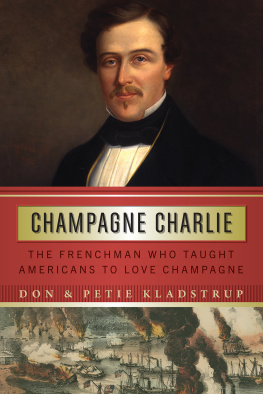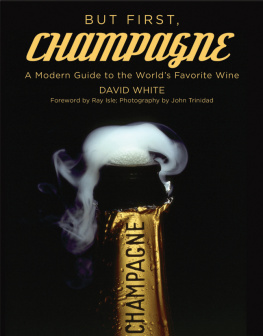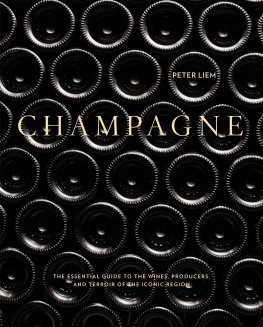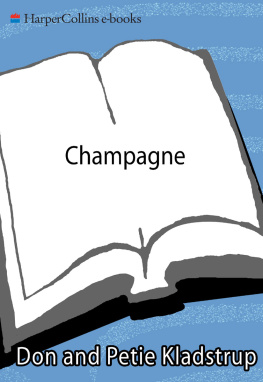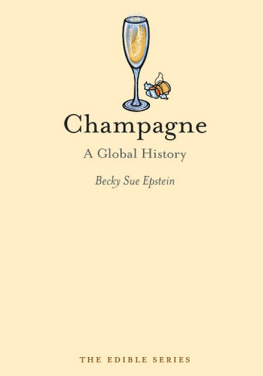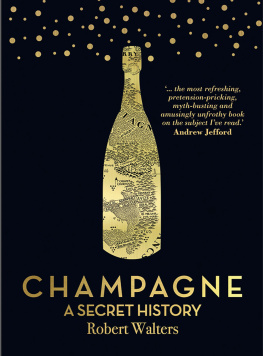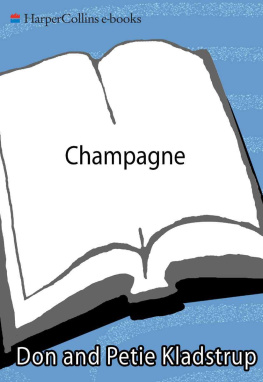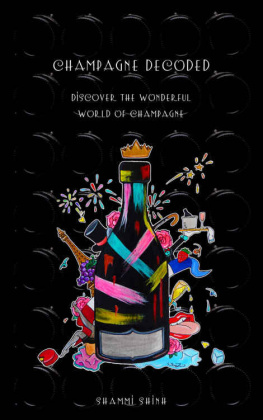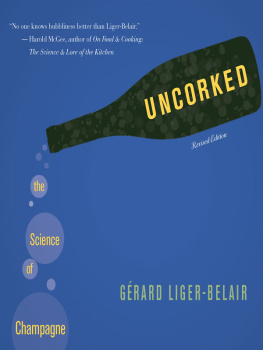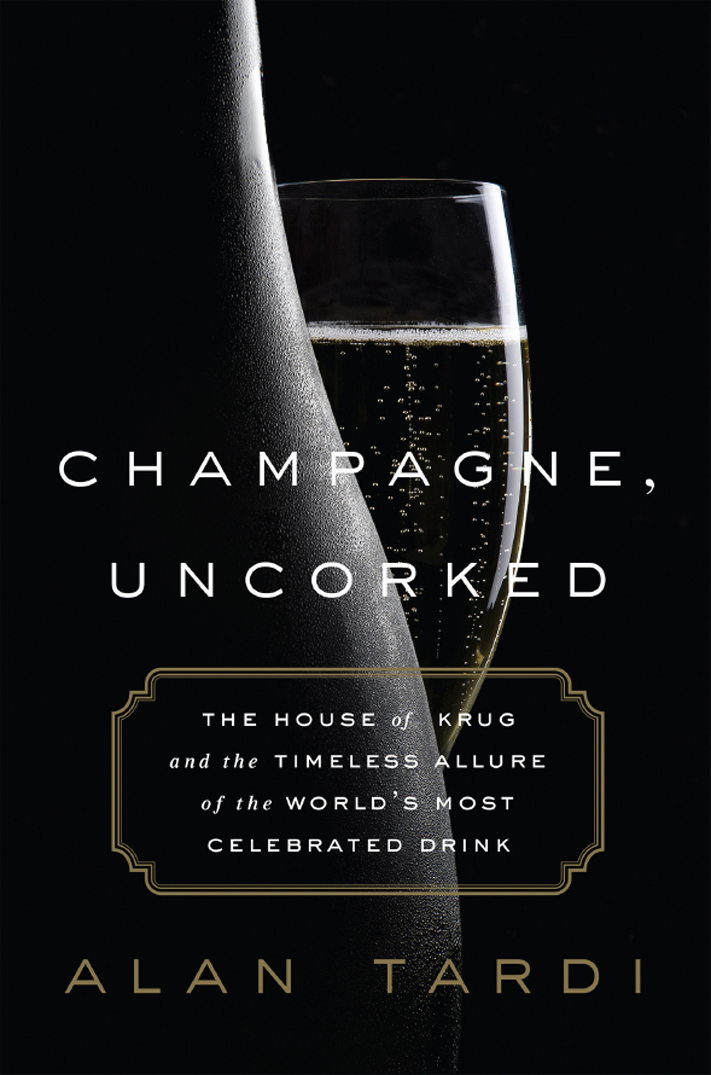

Copyright 2016 by Alan Tardi
Published in the United States by PublicAffairs, a Member of the Perseus Books Group.
All rights reserved.
Printed in the United States of America.
No part of this book may be reproduced in any manner whatsoever without written permission except in the case of brief quotations embodied in critical articles and reviews. For information, address PublicAffairs, 250 West 57th Street, 15th Floor, New York, NY 10107.
PublicAffairs books are available at special discounts for bulk purchases in the U.S. by corporations, institutions, and other organizations. For more information, please contact the Special Markets Department at the Perseus Books Group, 2300 Chestnut Street, Suite 200, Philadelphia, PA 19103, call (800) 810-4145, ext. 5000, or e-mail .
Set in 11.5-point Goudy Oldstyle STD
Library of Congress Cataloging-in-Publication Data
Names: Tardi, Alan, 1956 author.
Title: Champagne, uncorked: the house of Krug and the timeless allure of the worlds most celebrated drink / Alan Tardi.
Description: First edition. | New York: PublicAffairs, [2016] | Includes bibliographical references. Identifiers: LCCN 2016007400 | ISBN 9781610396899 (ebook)
Subjects: LCSH: Champagne (Wine)
Classification: LCC TP555. T37 2016 | DDC 641.2/224dc23
LC record available at http://lccn.loc.gov/2016007400
First Edition
10 9 8 7 6 5 4 3 2 1
To all the people of Champagne, past, present, and future, who through their limitless passion, consummate skill, and unshakeable commitment make Champagne the superlative libation that it is.
And to Fernanda and Lucia, who put the sparkle into my life.
THIS is a work of nonfiction, although I have taken the liberty to interpret events and motives, and some of the names of people I encountered on my visits to Champagne have been changed. Information deemed confidential or proprietary by Krug has been omitted.
Table of Contents
Guide
CONTENTS
GENIE IN THE BOTTLE
WINE exists on two different levels. One is earthly: a comestible beverage, a source of calories, an everyday ritual, a commodity, and, for some, a means of income. The other is extra-terrestrial: an agent of transformation, a mysterious elixir that can stimulate profound sensory experiences, stretching our capacities to smell, taste, see, and even touch; a potion that can magically lift us out of the daily routine and transport us to other times and places, nearby or far away, real or imagined, while at the same time locking us even deeper into a moment; a libation that can bring us from the earthly banal to higher realms of the poetic and even the divine.
These second-level transformational experiences dont have to be earth-shattering events announced by the sounding of celestial trumpets. They are often quite subtle and very brief, and their occurrence is unpredictable and impossible to induce. But anyone who truly loves wine will remember having had experiences like this.
There is also, perhaps, a third level on which wine exists: non-existence. Some people dont drink wine for medical reasons, some just dont like it, and others have either never had it or not yet developed a taste for it. And thats where I was for the first twenty years of my life.
I was born in Chicago and grew up in a suburb adjacent to the city that was dry. Illinois was not (and probably never will be) a wine-producing region, and wine was not a fixture on our table. Even on the rare occasions when it was there, such as Christmas dinner with the entire extended second-generation Italian family, the sour stuff was of no interest to me whatsoever. I much preferred the syrupy sweet carbonated beverage that midwesterners call pop.
Many years and two colleges later, I found myself in New York City and, with nearly two years of accumulated credits, decided to make a now-or-never push to finish my undergraduate degree in the facile, if not necessarily career-oriented, field of liberal arts. I enrolled in the undergraduate division of an alternative institution called the New School for Social Research and set about looking for a job to help finance my educational objective.
I got lucky: I walked into a restaurant and immediately got a job washing dishes (hey, a job is a job, I thought). Despite my lack of experience I did pretty well; I quickly got promoted to busboy, then waiter. Eventually I wandered into the open kitchen, and thats where I stayed.
Before that, the idea of cooking had never crossed my mind, but I liked the work, the schedule was flexible, and the money wasnt bad either. In addition to the exotic thrill of preparing food for paying customers, I also got the opportunity (thanks to the open kitchen) to watch them eat it, and much to my surprise, they seemed to enjoy it. I also noticed that many of them were drinking wine with their meal, and they seemed to be enjoying that too. I didnt really understand what the fuss was about; I had no notion of the concept of wine-food pairing and no firsthand experience of what wine could bring to the table. But watching people night after night eating and drinking and having a good time, it wasnt long before I became curious and wanted to try it for myself.
Not far from my school in the West Village was a tiny sliver of a restaurant called Chez Brigitte that consisted of a six-seat Formica counter and three tiny two-tops shoved up against the wall. Here, in the narrow kitchen behind the counter, Brigitte, with the help of a young French assistant, whipped up simple, inexpensive yet tasty food. In addition to the small printed menu, each day of the week featured a special dish such as coq au vin (Monday), gigot dagneau (Wednesday), or boeuf bourguignon (Thursday). I soon became a regular. I would go two or three times a week after classes, take a seat at the counter, and practice my French with Brigitte and her assistant while I ate.
On my well-trodden path from school to Chez Brigitte I regularly passed by a wine shop, and one evening I decided to pick up a half-bottle to bring with me. The selection of half bottles was limited, but it was a fine place to start. I tried whatever they had and soon began selecting the wine according to the daily special I knew would be on offer that evening: bordeaux with lamb, beaujolais with chicken, gigondas with duck. The French women seemed to get a kick out of it. I began offering them a taste of whatever I had, which they graciously accepted, eliciting comments such as Ah oui, cest trs bon! or Cest pas mal, pas mal de tout.
I dont remember any of the winesindeed, while perfectly acceptable, they were all remarkably unremarkablebut having them was fun: the rough wine complemented the homey food nicely, and opening the little bottle contributed a festive air to what had already become something of a ritual.
Then it happened.
One night, while heading home to write a paper about George Sand that was due the next day, I happened to pass by a different wine shop. Just for the heck of it, I went inside. Amidst the multitude of dusty bottles on the shelves and counters, my eye fell upon a thick, bulbous bottle with a handwritten label and an unfamiliar but intriguing name: Amarone.
When I got home, I lifted the bottle out of its crumpled brown paper bag, figured out how to chip the shiny red wax off the top, and carefully twisted the screw into the tight yet porous cork, thinking to have half a glass before attacking my homework.


